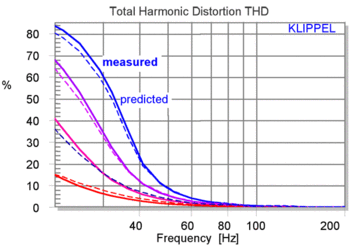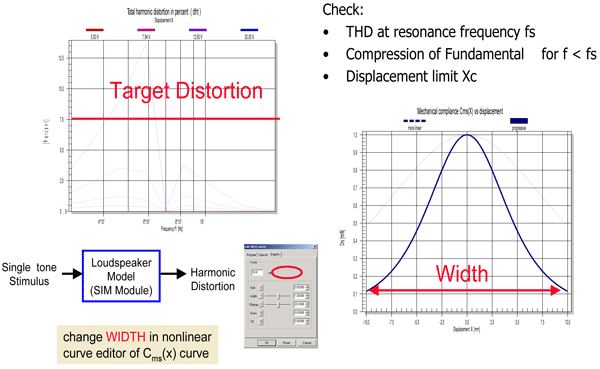Simulation (SIM)
Features and Benefits
- Determines maximal output
- Calculates voice coil, gap and magnet temperature
- Separates the effects of the individual nonlinearities
- Reveals dominant sources of distortion
- Shows mechanical and thermal load
- Helps to improve performance/cost ratio
- Saves time and cost in prototyping
This module performs a numerical prediction of the small and large signal performance of electro-dynamical transducers and complete systems using vented, sealed-box, band-pass enclosures and passive radiators. An extended model considers dominant nonlinearities of the driver (motor and suspension), the acoustical system (air compression, port losses, passive radiator suspension, Doppler effect), power dissipation and heat transfer using linear, nonlinear and thermal parameters of a real driver measured by the LSI module or fictitious parameters of a design choice. For a two-tone excitation signal, all electrical, mechanical and acoustical variables are calculated. The fundamental and distortion components (harmonics, intermodulation, dc component) are calculated by a spectral analysis. The SIM is a twin module of the DIS module to simplify the comparison of measured and predicted responses. Each nonlinearity in the system can be switched on and off to investigate its effect systematically. This reveals the dominant sources of distortion and gives valuable indications for driver optimization.
Specification
Requirements
Example
This figure illustrates the transformation of the target performance (permissible THD) into a transducer parameter (nonlinear shape of the nonlinear compliance Cms(x)) which is the basis for selecting the optimal driver for the system design. A nonlinear curve editor simplifies the generation of design choices.
Application Notes
Templates coming with the SIM module:
SIM closed box analysis | Maximal displacement, dc displacement, compression, SPL, distortion using large signal parameters imported from LSI BOX |
SIM Compression Out(In) | Output amplitude versus input amplitude at four frequencies using large signal parameters imported from LSI; simulated results are comparable with DIS Compression Out(In) |
SIM Equiv. Input Harmonics | Equivalent input harmonic distortion using large signal parameters imported from LSI; Simulated results are comparable with TRF Equiv. Input Harm. (SPL). |
SIM IM Dist. (bass sweep) | Intermodulation distortion in current and sound pressure by using a variable bass tone fs/4 < f1 < 4fs and a fixed voice tone f2 >> fs; Simulated results are comparable with DIS IM Dist. (bass sweep). |
SIM IM Dist. (voice sweep) | Intermodulation distortion in current and sound pressure by using a fixed bass tone f2 < fs and a variable voice tone f1>> fs; Simulated results are comparable with DIS IM Dist. (voice sweep). |
SIM Motor Stability | Checking motor stability according Application Note AN 14; Simulated results are comparable with DIS Motor stability. |
SIM Therm. Analysis (1 tone) | Heat transfer based on thermal parameters imported from LSI using a single-tone stimulus |
SIM Therm. Analysis (2 tone) | Heat transfer based on thermal parameters imported from LSI using a two-tone stimulus |
SIM vented box analysis | Maximal displacement, dc displacement, compression, SPL, harmonic distortion using large signal parameters imported from LSI BOX |
SIM X Fundamental, DC | Maximal displacement, dc displacement, compression using large signal parameters imported from LSI; Results are comparable with DIS X Fundamental, DC. |
SIM Separation AM Distortion | Amplitude modulation distortion according Application Note AN 10; Simulated results are comparable with DIS Separation AM Distortion. |
Related Information
Other Modules of the R&D System
- 3D Distortion Measurements (DIS)
Module performs a series of steady-state measurements by using a single- or two-tone excitation signal varied in frequency and voltage
Literature and Papers
Standards
International Electrotechnical Commission
IEC 60268-5, IEC 60268-7, IEC 60268-21, IEC 60268-22, IEC 62458, IEC WD 63034
European Standards
BS EN 54-24, BS EN 50332
Audio Engineering Society
AES2, AES56


